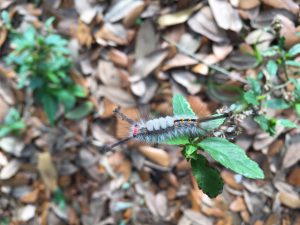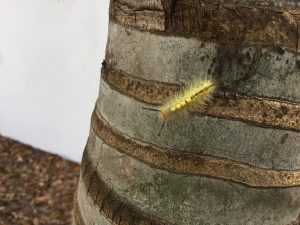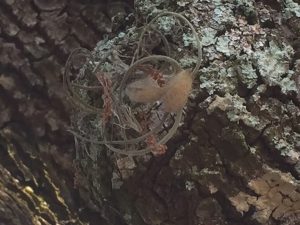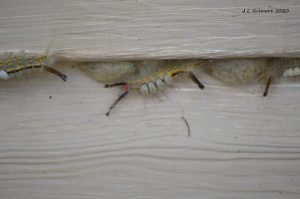Tussock moth caterpillar (Orgyia spp.)

Why the oak trees?

Over the last couple of weeks, if you have oak trees, you have probably seen tussock moth caterpillars (Orgyia spp.). They crawl all over anything underneath the trees. Oak trees are a host plant for the tussock moth caterpillar. Usually the caterpillars do not have much effect on the oak trees. Most commonly in Florida, you will find either the fir tussock moth (Orgyia detrita) or the whitemarked tussock moth (Orgyia leucostigma).
Cocoons, caterpillars, and safety

In addition to the caterpillars crawling all over, you may also notice their cocoons in trees (sometimes attached to ball moss) or on the sides of buildings. The Florida Museum of Natural History has more information on the difference between a cocoon and a chrysalis. If you see the caterpillars or their cocoons, avoid touching them as they may cause skin irritation or itching. Levels of sensitivity may vary from person to person.
Leave them alone, but if you must…

If you feel like you must remove the cocoons, use a broom to sweep them into a pail of soapy water. Otherwise, just avoid contact and watch out for the caterpillars! The larvae and caterpillars of tussock moths have plenty of natural enemies, including beetles, birds, wasp parasitoids, and pathogens. No need to add your name to that list! For more information on the tussock moth caterpillar, check out UF Featured Creatures.
References:
Hall, Donald H. and Lyle Buss. Tussock Moths-Orygia spp. EENY-588. Entomology and Nematology Department, University of Florida. http://entnemdept.ufl.edu/creatures/URBAN/MEDICAL/tussock_moths.htm.
Folt, John L., Tussock Moth Caterpillars in Northcentral Florida. Department of Entomology and Nematology, University of Florida/IFAS. https://ipm.ifas.ufl.edu/community/Tussock_Moth_Caterpillars_in_Northcentral_Florida.shtml.
An Equal Opportunity Institution.
 1
1
